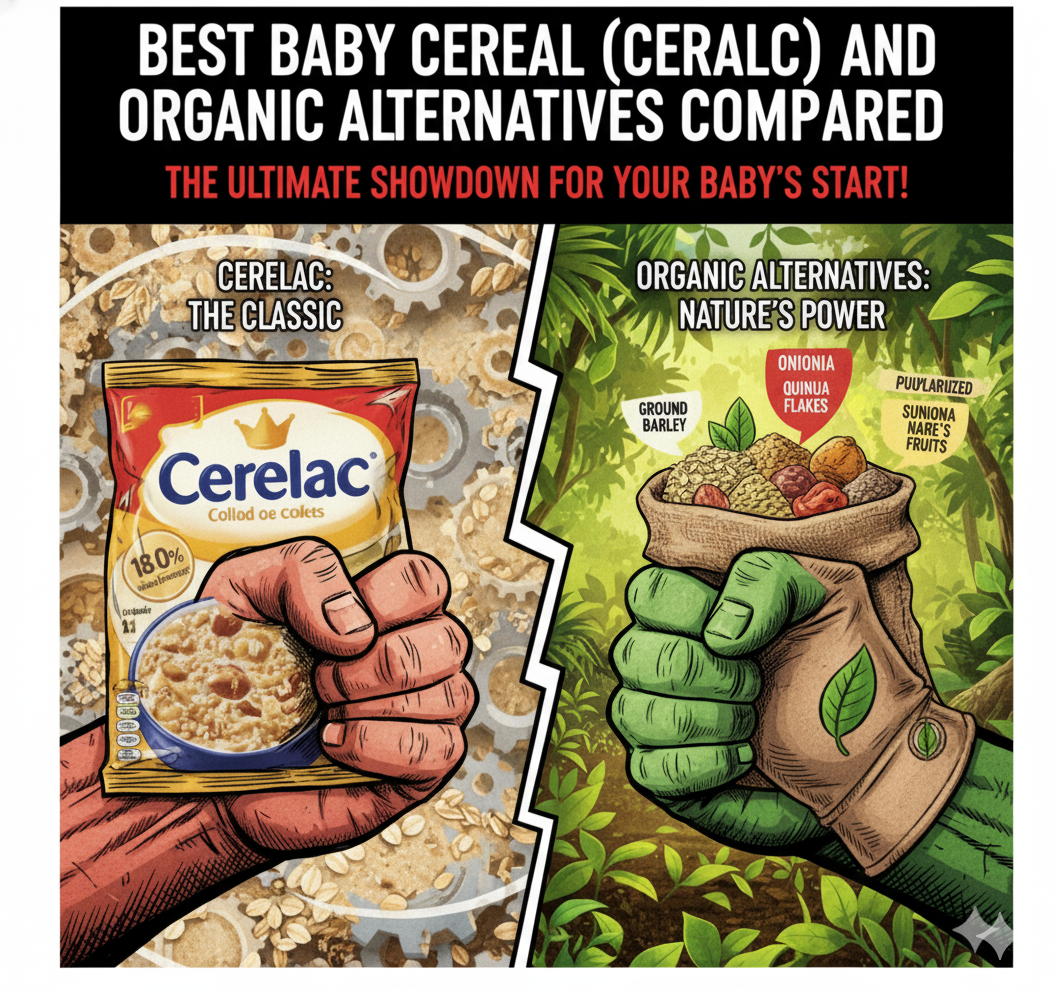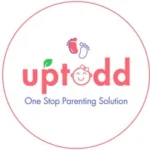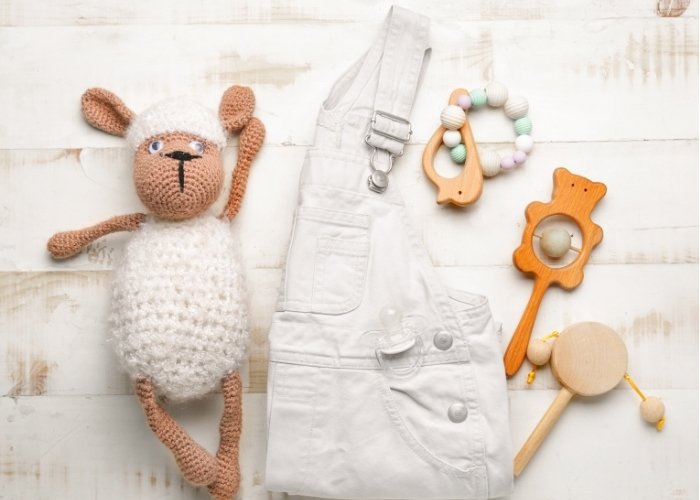
Newborn toys suggested by Experts
Topic
Newborn toys suggested by Experts
May start as early as
Birth
─────────
Related Skills
Introduction to Newborn Toys
When you first hear the news about becoming a parent, it’s one of life’s most joyful moments. The early days of parenthood are filled with new experiences and decisions from setting up the nursery to buying your baby’s first toy. Each choice, especially when it comes to newborn toys, can play a key role in shaping your baby’s early growth.
But with so many options on the market, it’s easy to feel lost. Do newborns even need toys? Which ones are safe? Which toys will actually help your baby’s development?
In this blog, our UpTodd parenting experts will walk you through everything you need to know about the best newborn toys, why they matter, and how to pick the right ones for your little one’s early months.
In this blog, we will cover:
- What factors to consider before buying newborn toys.
- Best toys for visual stimulation and movement.
- Toys that support hearing and touch through sound and texture.
- Expert insights on how toys aid early brain development.
- Answers to most searched newborn FAQs (based on parent queries).
- Interlinked resources from UpTodd’s expert parenting guides.
But what factors should you consider before buying toys for your newborn?
Out of so many options, finding the right toys that are fun, safe, and beneficial for your baby’s development can feel overwhelming. Every toy should serve a purpose whether it’s comforting your baby, encouraging curiosity, or stimulating growth.
1. Safety Comes First
- Choose toys that are BPA-free, lead-free, and non-toxic.
- Avoid sharp edges and small detachable parts.
- Go for toys with soft finishes and baby safe textures.
2. Encourage Sensory Development
Babies use their senses to understand the world. Pick toys that support:
- Vision: High contrast black and white patterns.
- Hearing: Soft rattles, musical mobiles, and plush sound toys.
- Touch: Textured fabrics and soft surfaces.
3. Simple is Better
Newborns don’t need flashy toys. Avoid harsh lights and loud sounds. Calm, simple, and tactile toys encourage focus and help build attention span naturally.
👉 Learn more: How Toys Build Early Brain Development
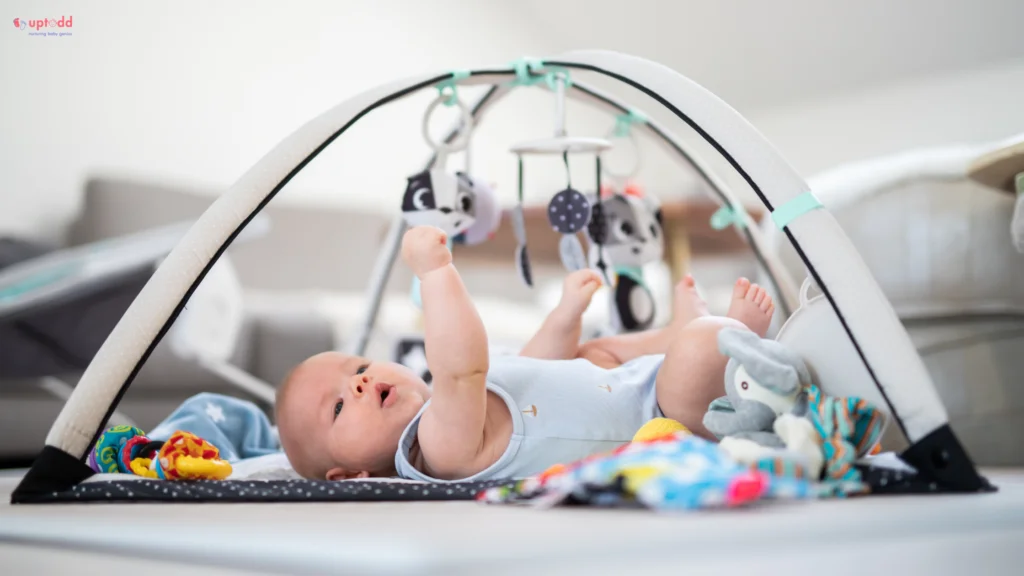
High contrast patterns
Your newborn baby’s vision is still developing and they are seeing the world in blurry shades of black, white, and grey. But why high contrast patterns? Babies are drawn to high contrast shapes and patterns because their eyes are able to distinguish these differences more easily. This is because, at birth, a baby’s retina isn’t fully developed. This allows them to see only about 10-12 inches away and distinguish extreme contrasts like black and white.
Bold black and white images also stimulate the development of their optic nerves, strengthening their vision. They send strong signals to a baby’s brain, promoting brain growth and faster visual development. In fact, high contrast patterns help babies’ eyes learn to coordinate, improving eye movements and attention span.
References taken from Pattern Vision in Newborn Infants
Interactive elements like sound
We all love music! Don’t we? but did we know that it does wonders for our little ones’ auditory and cognitive development? According to a research by Friederike Barbara Haslbeck and Dirk Bassler, music and sounds stimulate a baby’s auditory and prefrontal cortexes. It also contributes to their social and emotional development by stimulating the formation of brain chemicals such as dopamine and oxytocin. Newborns are not able to see properly, but they can hear very well. Thus, the use of sound can be an excellent way to provide them with stimulation along with developing their tracking skills. Go on and bring some musical toys to see your little one react with happiness and curiosity,
References from Baby music: The soundtrack to your child’s development
Touch
Newborns explore the world primarily through touch, so toys with different textures can be an amazing tool to enhance their sensory development. As babies feel different textures and materials, they start to understand their environment in a better manner
Movement
In the first three months, your baby’s eyesight is still developing and they can see a moving object more easily than a stationary one. Movement catches their attention and helps them practice coordinating their eye movements. Studies also show that Motion processing develops early in infants, making it easier for newborns to notice and follow moving objects, even when they struggle to see stationary ones clearly.
References from Development of human visual function
High Contrast Flashcards
These cards feature bold patterns that capture your baby’s attention.
- Improve focus, eye coordination, and visual tracking.
- Stimulate the optic nerve and brain development.
- Double as a bonding tool during tummy time.
📖 Based on research from “Pattern Vision in Newborn Infants.”
Newborn Toys for visual stimulation and movement
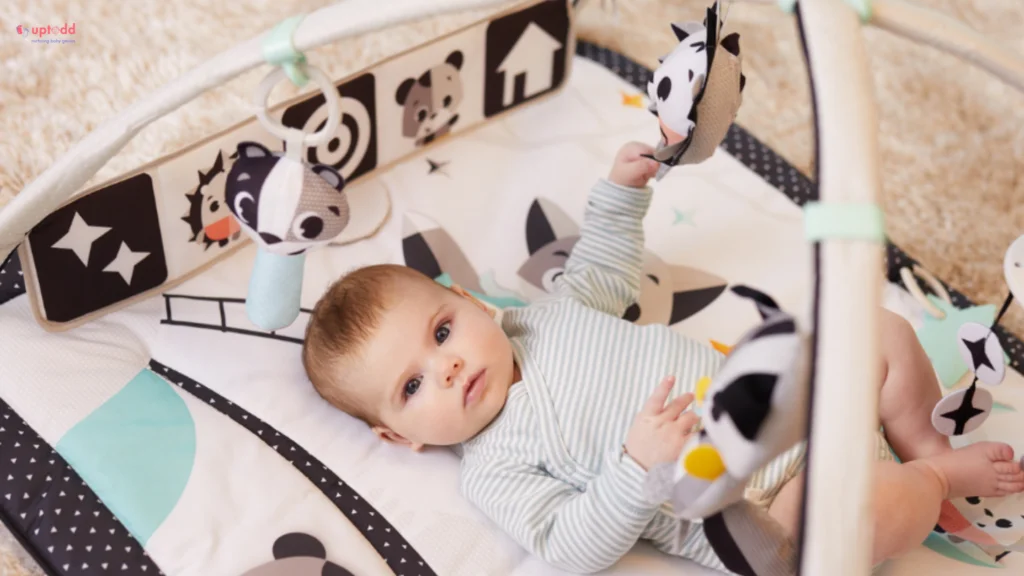
High contrast black and white flashcards
These cards consist of bold, high contrast images that captivate your baby’s attention and are amazing for their vision development. The simple shapes and patterns in these cards are easy for your baby to see and can help in improving their focus and visual tracking skills. Plus, spending time showing these cards to your baby can be a wonderful bonding experience. That’s definitely an additional benefit! right?
References from Detection of contrast by the newborn and 2-month-old infant
Black and white hanging mobiles
We have one more amazing toy suggestion for the high contrast stimulations, and that is a black and white hanging mobile. Hanging a mobile toy with high contrast patterns above your baby’s crib provides visual stimulation and helps strengthen their developing eye muscles as they track the moving shapes.
References from Why do babies need black and white toys?
Black and White Hanging Mobiles
- Help strengthen developing eye muscles by encouraging your baby to follow moving shapes.
- Improve spatial awareness and visual depth perception.
- Best placed above the crib or changing table for safe engagement.
📖 Supported by research from “Why Do Babies Need Black and White Toys?”
Newborn Toys with interactive elements and sounds
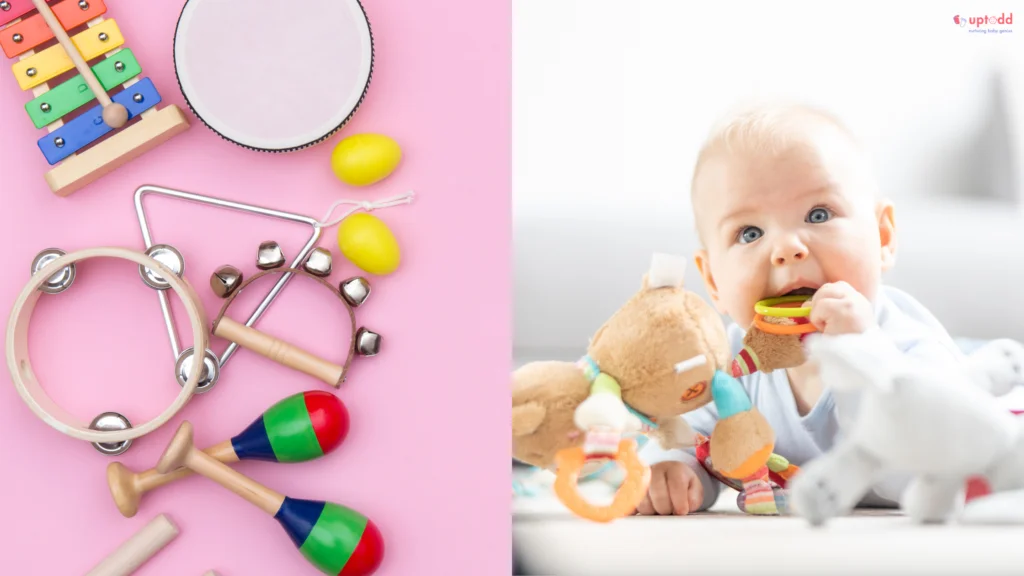
Musical Mobiles
These are the hanging mobiles that not only provide visual stimulation but also play soothing lullabies or nature sounds. And what makes our babies happier than the gentle movement combined with calming music. These are an amazing tool to help soothe your baby to sleep while supporting their auditory development.
Key Points Newborn Toys
- Combine gentle movement with lullabies to calm and soothe.
- Improve auditory recognition and promote sleep.
- Perfect for bedtime or relaxation routines.
Soft Rattles
Every baby loves rattles. Rattles produce gentle sounds that can captivate your baby’s attention and encourage them to reach out and grasp the toy, promoting both auditory and motor skills. The sound of the rattle can also help your baby learn cause and effect, that when they shake it, a sound is there. Isn’t it fun?
Key Points Newborn Toys
- Help babies connect movement with sound (cause and effect).
- Encourage grasping and improve fine motor coordination.
- Easy to clean and carry ideal for newborns and travel.
Musical Plush Toys
Plush toys have been a lovely part of our childhood and they can be of our babies as well. Plush toys are small soft toys that play music when squeezed. They offer a very comforting and interactive experience for our little ones. They can become a beloved companion for your baby, providing both comfort and a multisensorial experience.
Key Points Newborn Toys
- Provide a multisensory experience (touch + sound).
- Help babies learn to associate comfort with sound.
- Ideal for emotional security and playtime engagement.
Talking Cactus Toy
Recently one toy gained a lot of hype and that is the talking cactus toy. This lively fun toy playfully repeats words and sounds, often accompanied by funny dances or movements. It also has some amazing catchy tunes to keep your little one entertained. But It’s not just about entertainment! This interactive toy helps babies learn about cause and effect as they discover that their sounds or actions can prompt a response from the toy. This toy is also amazing for their language development and communication skills!
Key Points Newborn Toys
- Mimics sounds and repeats voices, encouraging babies to recognize their own voice.
- Supports early language and communication development.
- Use in short, supervised sessions to prevent overstimulation.
Toys with Interactive Elements and Sounds
Sound is one of the first senses to fully develop. Babies respond to soothing, rhythmic tones that build familiarity and emotional security.
👉 Explore: Dancing Cactus Toy Review x
Expert View: Dr. Nary (Child Specialist, UpTodd Research Team)
In my years of research, I’ve found that newborn toys do far more than entertain they build the foundation for lifelong learning. Visual toys help stimulate brain pathways, sound toys strengthen communication, and textured objects refine motor control. Early stimulation using safe, research backed toys enhances memory, curiosity, and bonding. When parents play with their babies using these toys, they’re not just creating fun moments — they’re shaping brain architecture
Conclusion
We understand that choosing the right toys for your newborn can be challenging, but it doesn’t have to be. The right toys can help your baby see better, hear sharper, feel deeper, and bond stronger.
Choose toys that are safe, simple, and sensory-rich. Focus on black and white visuals for early sight, soft rattles for sound recognition, and plush textures for tactile learning. Avoid overstimulation — babies learn best in calm, loving environments.
At UpTodd, our experts recommend creating a balanced toy mix:
- 1–2 high contrast toys for vision
- 1–2 soft sound toys for hearing
- 1 tactile toy for touch and comfort
These few, purposeful toys are enough to nurture your newborn’s development in the first months of life.
👉 Explore UpTodd to discover curated toy recommendations and baby development programs
FAQs
Q1. How to take care of a newborn baby?
Focus on gentle routines: feeding, sleep, hygiene, and sensory stimulation. Playtime with soft, soothing toys builds connection and comfort.
Q2. Can newborn babies see?
At birth, babies see only high contrast patterns within 12 inches. Using black and white toys helps strengthen vision and tracking ability.
Q3.How to feed a newborn baby?
Feed on demand, about every 2–3 hours. During or after feeding, show your baby visual or musical toys to engage focus and recognition.
Q4.How to increase newborn baby weight?
Adequate feeding, rest, and a calm environment are essential. Gentle play with soft toys and mobiles supports emotional well being, which indirectly promotes growth.
Q5.How to breastfeed a newborn baby?
Ensure proper latching and a quiet setting. Use soothing background toys like musical mobiles to help your baby relax during feeding.
Q6.How many bones are there in a newborn baby?
Newborns have around 300 bones, many of which fuse as they grow. Encourage gentle play — no hard toys or heavy items at this stage.
Q7.How to wish a newborn baby?
A warm smile, soft voice, and gentle touch mean more than words. Introduce plush musical toys as early companions to comfort and engage them..
Explore UpTodd to unleash hidden abilities of the baby.
Explore More
Baby Toys: Best Picks (Master Cluster)
Why Wooden Toys Must Be Your Baby’s Toys
Montessori Toys: How to Choose Them for Your Toddler
Research & Resources
- https://www.unicef.org/parenting/child-development/baby-music-soundtrack-to-development
- https://www.sciencedirect.com/science/article/pii/S004269891100068X
- https://www.sciencedirect.com/science/article/abs/pii/S016363838480003X
- https://www.thelittlesensorybox.com/blogs/why-babies-need-black-and-white-visual-stimulation/why-do-babies-need-black-and-white-toys
- https://pubmed.ncbi.nlm.nih.gov/17788054/

